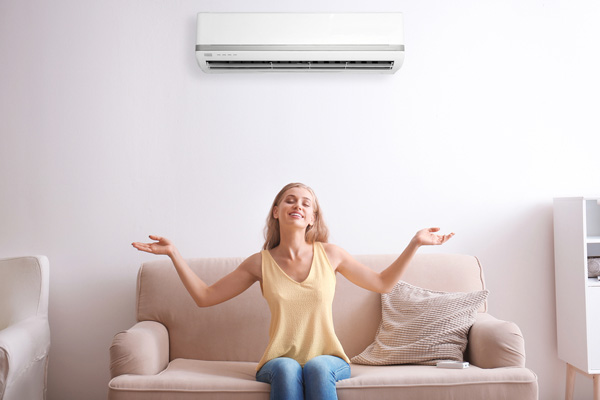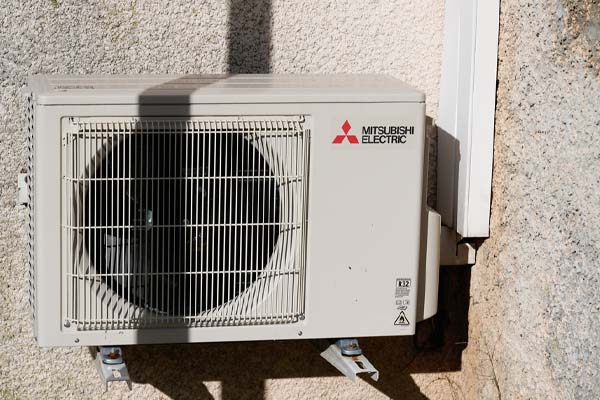
Ductless cooling systems are becoming increasingly popular due to their efficiency and convenience. Unlike central air conditioners, ductless ACs operate without ducts, delivering cold air directly into a specific space or room. This makes them a great alternative for homeowners who don’t need to cool their entire house or don’t have the space for ductwork. In this article, we answer the question, “How do ductless air conditioners work?”.
How Do Ductless Air Conditioners Work?
Ductless ACs consist of three main components, each having a specific function. The evaporator/blower unit is the indoor part of the AC. This part sits in the room being cooled. Its job is to pull in warm air, absorb the moisture and heat from the air, and then channel cold air back into the room.
The conduit is a thin, long cable that connects the indoor unit to the outdoor condenser. This conduit provides power to both the indoor and outdoor units. It also channels the moisture and heat from the indoor unit to the condenser.
Finally, the condenser is the outdoor component of the ductless air conditioning system. This is the part responsible for removing the heat from inside the house and releasing it outside.
How Ductless Air Conditioners Work

When you turn on a ductless air conditioner, the blower unit draws in warm air from the room and passes it over the evaporator coil, which removes moisture and heat from the air. The resulting cool air is then directed back into the room by the blower. The moisture and heat removed from the air are then channeled through the conduit to the condenser unit, which releases it outside. This process continues until the desired temperature is achieved.
Single-Zone Mini-Split Vs. Multi-Zone Ductless HVAC Setups
Ductless air conditioners are suitable for both single-room and multi-zone cooling applications. You can choose between a single-zone mini-split or a multi-zone ductless HVAC setup, depending on your cooling needs.
- Single-Zone Ductless Mini-Split: A single-zone mini-split consists of a single evaporator/blower unit and an outdoor condenser. This unit is perfect for cooling a single room. You can install multiple mini-splits with their respective condensers in large spaces to cool the entire building. This type of setup allows for customizable temperature control in each zone. Moreover, if one unit malfunctions, the others will continue to operate without being affected.
- Multi-Zone Ductless HVAC: Multi-zone ductless HVAC systems come in two variants. The first variant features a single outdoor condenser connected to multiple indoor evaporator/blower units. Each indoor unit is connected to a thermostat, and when there’s a need for cooling, all units are set off simultaneously. This configuration is more cost-effective and ideal for buildings where all rooms have different cooling loads.
If you want a customizable system that allows for true zoning, get a multi-zone mini-split system that comes with detached compressor circuits linked to each evaporator/blower unit.
Do Ductless Air Conditioners Have Adequate Cooling Power?
Ductless air conditioning systems are designed to provide effective cooling for a single zone or room. While the indoor units may appear small, they are capable of efficiently cooling a room, provided that the BTU capacity of the unit is appropriately matched to the room size. It is advisable to consult with a licensed HVAC contractor to determine the right BTU capacity for your specific needs.
One of the main considerations when choosing a ductless AC system is the BTU rating. Generally, the larger the room, the higher the BTU rating required. Select a system with the appropriate BTU capacity to avoid overworking or short cycling. Both of these issues can damage your system and leave you with frequent repair bills.
For rooms measuring between 400 and 650 square feet, a unit providing 12,000 BTUs per hour is typically sufficient. For rooms measuring between 600 and 1000 square feet, a unit providing 18,000 BTUs per hour is recommended. For larger rooms measuring between 800 and 13,000 square feet, a unit providing 24,000 BTUs per hour may be required.
Consulting with a licensed HVAC contractor can provide valuable insights into the optimal ductless air conditioning system for your needs. The professional can assess various factors, such as the room size, insulation, and the number of windows, to ensure that you select a system that is appropriately sized and capable of providing efficient cooling.
Pros & Cons of Ductless Air Conditioners

Ductless air conditioning systems have been a popular alternative to central ACs and window units for many homeowners. These systems, also known as mini-split air conditioners, consist of an outdoor unit and one or more indoor units that work together to cool your home. Here are some pros and cons to consider when deciding whether to install a ductless AC system in your home.
Pros of Ductless Cooling Systems
- In-Built Zoning: One of the most significant advantages of ductless AC is the zoning feature. Each indoor unit is equipped with its own thermostat and can be independently controlled. This means that you can customize the temperature of each room. This feature is especially helpful in homes where different rooms have different cooling needs or for people who prefer varying temperatures in different rooms.
- Energy Efficiency: According to Enegery.gov, traditional central AC systems have a disadvantage in that they often lose 20 to 30 percent of the conditioned air due to duct leaks. Ductless air conditioners, on the other hand, don’t require ducts. This means they are more energy efficient and will save you money on your utility bills over time.
- Versatility: Ductless ACs are versatile and, therefore, can be installed in a variety of settings. They can be mounted on walls, floors, and ceilings, depending on the layout of your home. This flexibility makes them ideal for both small apartments and large homes.
- Cost-Effective: Ductless ACs can be more cost-effective than traditional central air conditioning systems because they don’t require any pre-installed ductwork. Installing ductwork is often time-consuming and expensive, especially for older homes that weren’t built with ductwork. Ductless systems can save you money by eliminating the need to install ducts.
Cons of Ductless Air Conditioning Systems
- Higher Upfront Costs: Ductless AC systems typically cost more upfront than window units or central ACs. However, as mentioned earlier, the lack of ductwork can make them more cost-effective in the long run. Moreover, the high upfront cost is often offset by the energy savings that come with using a more efficient cooling system.
- Visibility: Ductless air conditioners are often mounted on walls, floors, or ceilings. This means they’re visible and may not fit in with your home’s aesthetic. However, the units are often sleeker and less obtrusive than window units.
Ductless air conditioners offer many advantages over traditional central ACs and window units. Their pros include energy efficiency, customizable zoning, and versatility. While they may cost more upfront, they can save you money in the long run by reducing energy waste and eliminating the need for expensive ductwork.
Ductless air conditioners have numerous benefits, including the ability to customize temperature control settings, their versatility, and energy efficiency. Additionally, since they do not require ductwork, they are generally more affordable to install and maintain than central air conditioners.
Call Wilcox Energy For Trusted HVAC Services

For all your heating and cooling needs throughout the southern Connecticut shoreline, Wilcox Energy offers excellent services. We employ certified technicians who are knowledgeable and experienced in providing top-notch HVAC installations, inspections, tune-ups, repairs, and replacements. Our maintenance services can enhance your comfort, increase energy efficiency, and lower your home’s energy bills.
At Wilcox Energy, we guarantee that our prices for heating and cooling services are the most competitive in the area. If you need HVAC repair or replacement, our experienced team can help you find the best option for you based on your home and budget. We stand behind our work and offer a guarantee for all our services. Contact us today to schedule a service appointment and take advantage of our free, in-home estimates.
For more information about our HVAC services, be sure to contact Wilcox Energy. You can click here to contact us, or you can call us at (860) 399-6218 to find out more. We offer a full line of heating and cooling repairs, maintenance services, and installations. Click the link to view our service area.
